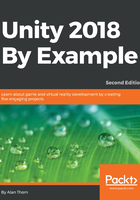
Preface
Video games are a cultural phenomenon that has captivated, entertained, and moved billions of people worldwide over the past 50 years. As an industry and movement, video games are an exciting place to be, both for the developer and the artist. In these roles, your vision, ideas, and work can influence wide audiences, shaping and changing generation after generation in an unprecedented way. In more recent times, there's been a general movement toward democratizing game development, making the development process simpler, smoother, and more accessible to a wider audience, including developers perhaps working from home on a very limited budget. Instrumental in this movement is the Unity engine, which forms the main subject of this book. The Unity engine is a computer program that works with your existing asset pipeline (such as 3D modeling software) and is intended for compiling video games that work seamlessly across multiple platforms and devices, including Windows, Mac, Linux, Android, iOS, and Windows Phone. Using Unity, developers import ready-made assets (such as music, textures, and 3D models), and assemble them into a coherent whole, forming a game world that works by a unified logic. Unity is an amazing program. The latest version is free for most people to download and use, and it works well with many other programs, including free software such as GIMP and Blender. This book focuses on the Unity engine and how it can be used in a practical context for making playable and fun games. No prior knowledge of Unity is expected, although some knowledge of programming and scripting (such as JavaScript, ActionScript, C, C++, Java, or C#) would be beneficial. Let's now take a look at what this book covers, on a chapter-by-chapter basis.